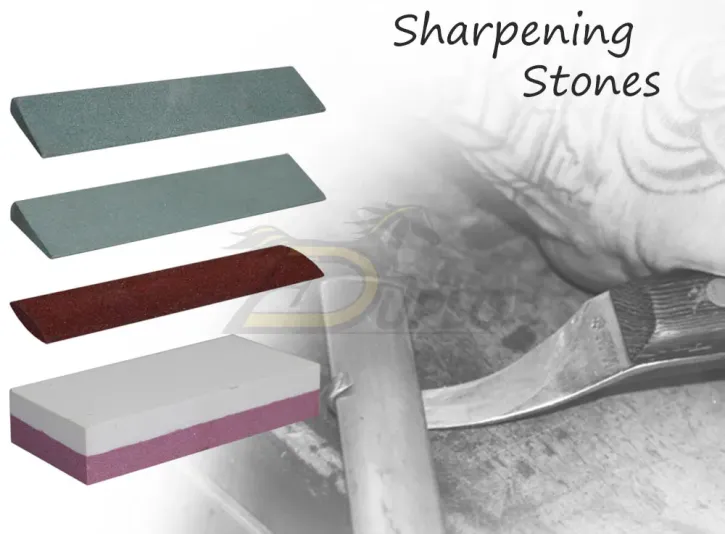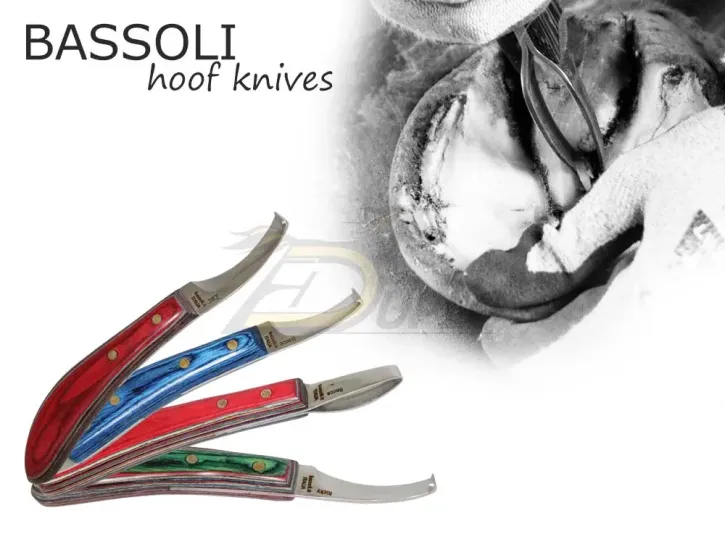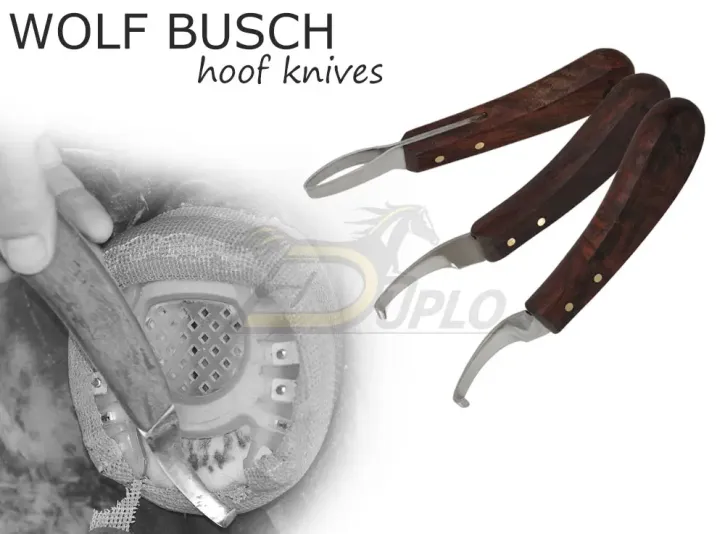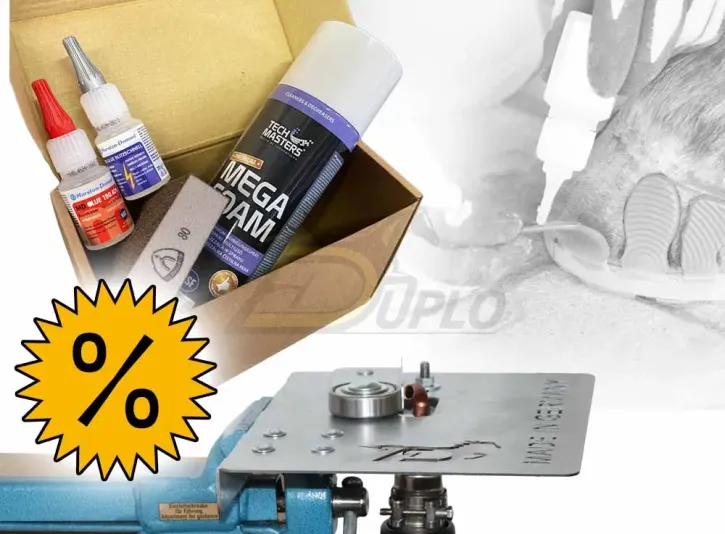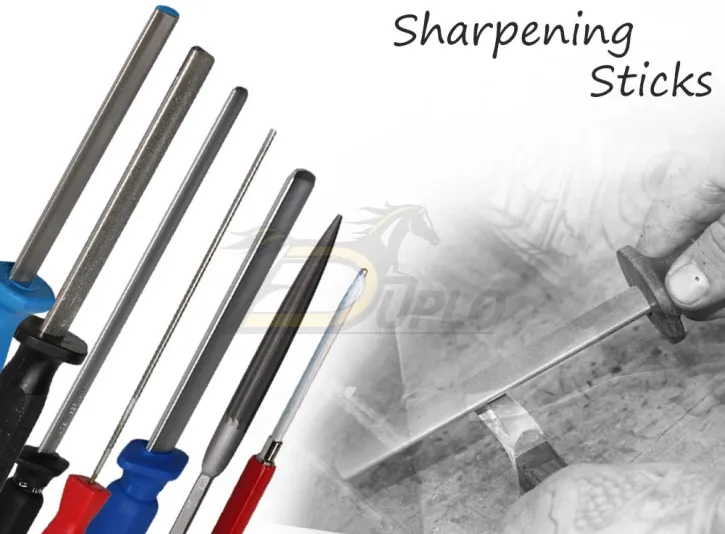Sharpening Stone and Whetstone for Sharp Hoof & Toeing Knives
Even the best hoof knife only cuts well if it’s sharp. Dull blades make trimming more difficult and increase the risk of injury. One way to keep the blade of the hoof knife or toeing knife sharp is by using a a sharpening stone or whetstone.
Sharpening Hoof Knives – Whetstone vs. Sharpening Stone
Although the terms whetstone and sharpening stone are often used interchangeably, they don’t mean the same thing. A whetstone is generally used to sharpen dull blades. It removes more material from the edge than a sharpening stone, effectively creating a new cutting edge. That’s why a whetstone is also suitable for establishing the primary grind .
The sharpening stone, also known as a fine sharpening stone, usually has a finer grit and removes less material. A sharpening stone with a fine grit is primarily used to extend the lifespan of the knife blade. It’s ideal for resharpening or polishing an already sharpened edge.
You can tell whether a sharpening stone is coarse or fine by looking at the grit size. Stones with a higher grit are finer; those with a lower grit are coarser. The coarser the stone, the more material it removes while sharpening—hence the term whetstone.

Of course, when sharpening with a stone, everyone eventually develops their own method. Often, it makes sense to combine both grit types—starting with a whetstone and finishing with a sharpening stone.
The Right Sharpening Stone
In addition to grit size, there are other factors to consider when choosing the right sharpening stone.
The Shape of the Sharpening Stone
Depending on the shape, sharpening stones are more or less suitable for the blades used in hoof care. The flat-oval shape, in particular, fits the contour of the hoof knife perfectly, allowing for precise and efficient sharpening.
The Right Lubricant – Water vs. Oil
Water and oil are both suitable as lubricants for sharpening. Which one is better depends primarily on the pore structure and the material of the stone. Oil stones are generally made from harder materials than water stones. A water stone can absorb water and release it during sharpening. The porous structure of a water stone also helps remove metal particles during use. Common materials for water stones include corundum and ceramic. Oil stones are often made of aluminum oxide and silicon carbide. Of course, depending on the manufacturer, there are differences—some stones can be used with either water or oil. However, once you choose a lubricant, you must stick with it. Switching lubricants can clog the sharpening stone or lead to uneven sharpening.

Depending on the manufacturer, when using water as a lubricant, it may be necessary to soak the sharpening stone in water for a few minutes before use. This allows it to absorb water fully and generate the required slurry. Some water stones, however, only need to be dampened, making them quicker to prepare. In general, a water stone has absorbed enough water when no more air bubbles rise to the surface. The advantage of working with water stones is clear – water is environmentally friendly, readily available, and especially with softer stones, it provides faster sharpening performance. However, water stones need to be flattened more frequently than oil stones.
Oil stones, on the other hand, typically offer more consistent sharpening performance, reducing the need for reworking. They also tend to last longer – oil stones retain their shape better and need to be dressed less often than water stones.
Your Selection of Sharpening Tools for Hoof Knife Maintenance
Dick Rectangular Combination Stone:
Sharpening Stone & Whetstone in One Product

- Grit: 280 and 120
- Abrasive quality: Refined corundum
Dick Whetstone
Flat-Oval Shape

- Grit: 180
- Abrasive quality: Refined corundum
Flat-Oval Sharpening Stone
or Whetstone

- Grit: 280 or 180
- Abrasive quality: Silicon carbide
Application and Safety Instructions for Using Sharpening Stones
In the FAQ → Safety section, we've compiled all the important safety information for working with sharpening tools like the sharpening stone or whetstone.
How to Use the Sharpening Stone Correctly
Over time, everyone develops their own technique and finds their favorite combination of sharpening tools to keep hoof knives and toeing knives sharp. However, some basic principles should always be followed—regardless of the stone or lubricant used.
- Prepare your water or oil stone according to the instructions.
- Ensure a flat, stable surface for your sharpening work.
- Select the right grit based on how dull your blade is. It's often best to start with a coarse grit to remove damage, then move to finer grits to achieve the desired sharpness.
- Use consistent pressure and maintain the correct angle while sharpening.
- After sharpening, clean both the knife and the sharpening stone thoroughly.
Personal Protective Equipment
Always wear cut-resistant, non-slip gloves when sharpening to prevent injuries from slipping blades. Protect your eyes from metal particles and grinding debris. Make sure you work on a stable surface when using sharpening stones.
Condition of the Sharpening Stone
Check your stone for damage before each use and only use it if it is in perfect condition. Cracks or loose fragments may pose a safety risk.
Usage and Additional Warnings
Use sharpening stones only for their intended purpose as specified by the manufacturer. Achieving a good result depends on using the correct angle and technique. Caution: After sharpening, knives and blades are extremely sharp. Always test sharpness and continue working with great care.
General Information About Sharpening Stones / Grinding Stones
| Product Details and Delivery Information | |
|---|---|
| Product Category | Sharpening Stones |
| Items | Sharpening Stone, Whetstone |
| Brands | Dick, Others |
| Function | depending on grit and abrasive quality: primary grind, resharpening, honing and polishing of hoof knives and toeing knives |
| Packaging Unit | sold individually |
| Returns and Exchanges |
Available under certain conditions within 3 months inside the European Union (EU). For returns outside the EU, please contact our customer service. Full details can be found in the FAQ → Service & Conditions section. |

